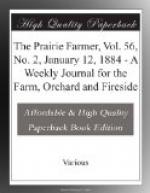CHURNING TEMPERATURE.
A correspondent of the New England Homestead found difficulty in making the butter “come” from cream raised in the Cooley Creamer. In a later issue several correspondents tried to help her through the difficulty. One said:
First of all be sure your cream is ready to come before you churn it. If you have no floating thermometer, please get one right away. Deep set cream needs not only to be ripened, but the temperature must be right—not less than 62 degrees, and 65 degrees is better. Don’t guess at it, but be sure. Mix each skimming with the others thoroughly, and keep the cream pail in a warm place at all times.
Another said: Keep the cream at 60 degrees to 65 degrees all the time before it goes into the churn. Take care to thoroughly mix the different skimmings. Sometimes in cold weather the butter will nearly come, and then hold on without any advance. In such cases, put into a thirty-quart churning, half a cupful of salt and four quarts of water heated to 55 degrees; it will cut the butter from the buttermilk in five minutes. My butter sells for fifty cents a pound and this is the way I manage.
Another: Sour your cream before churning and have it as near 62 degrees as you can, and you will have no trouble. The first fall we had the Cooley we had one churning that would not come into butter. I found it was perfectly sweet. Since then I have been particular to have it ripe and have had no trouble.
SEAS OF MILK.
A newspaper correspondent contributes the following which is of course made up of a mixture of facts and guesses. But as it is somewhere near the truth, as a general thing, we do as all the rest of the papers are doing, print it.
“There are nearly $2,000,250,000 invested in the dairying business in this country,” said an officer of the Erie Milk Producers’ Association yesterday. “That amount is almost double the money invested in banking and commercial industries, it is estimated that it requires 15,000,000 cows to supply the demand for milk and its products in the United States. To feed these cows 60,000,000 acres of land are under cultivation. The agricultural and dairy machinery and implements in use are worth over $200,000,000. The men employed in the business number 700,000 and the horses nearly 1,000,000. The cows and horses consume annually 30,000,000 tons of hay, nearly 90,000,000 bushels of corn meal, about the same amount of oat-meal, 275,000,000 bushels of oats, 2,000,000 bushels of bran, and 30,000,000 bushels of corn, to say nothing of the brewery grains and questionable feed of various kinds that is used to a great extent. It costs $400,000,000 to feed these cows and horses. The average price paid to the laborers necessary in the dairy business is probably $20 a month, amounting to $168,000,000 a year.




